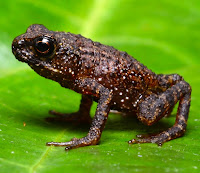[Most Recent Entries] [Calendar View]
Saturday, May 11th, 2024
| Time | Event | ||||
| 7:27a | [Herpetology • 2024] Enduring the Earthquake: Rediscovery of the Critically Endangered Mesilau Stream Toad, Ansonia guibei Inger, 1966 (Anura: Bufonidae) and its Conservation Implications
Abstract The Mesilau Stream Toad (Ansonia guibei) is a species of bufonid endemic to Sabah, Borneo, and restricted to a single mountainous location above 1600m in elevation. The species is only known from the type locality, the Mesilau watershed on Mount Kinabalu. An earthquake in 2015 resulted in massive landslides, causing extensive damage to the species’ habitat at Mesilau. This event was expected to have caused significant population declines of at least 80% or even the potential extinction of the species. A survey in 2017 at Mesilau failed to locate any individuals, which resulted in it being listed as Critically Endangered by the IUCN. Surveys in late 2023 to reassess the status of the species and its habitat resulted in the rediscovery of a single subadult specimen of A. guibei. Tadpoles of the species were recorded in the main Mesilau River and one additional tributary, which indicates the species survives and is breeding. Studies are ongoing to collect more ecological data on the species and determine its current distribution. The data gathered will be used to construct a robust conservation plan for the species. Nevertheless, these preliminary observations bode well for the future of the species as it demonstrates that it is resilient and capable of recovering from the damages caused by the earthquake. Amphibia, Amphibian, Borneo, endemism, IUCN Red List, Mount Kinabalu, Sabah Evan S.H. Quah, Paul Yambun Imbun and Sze Huei Yek. 2024. Enduring the Earthquake: Rediscovery of the Critically Endangered Mesilau Stream Toad, Ansonia guibei Inger, 1966 (Anura, Bufonidae) and its Conservation Implications. Zootaxa. 5447(2); 253-262. DOI: 10.11646/zootaxa.5447.2.6 | ||||
| 2:40p | [Entomology • 2023] Protosticta sexcoloratus • A New Species of Protosticta Selys, 1885 (Odonata: Zygoptera: Platystictidae) from the Western Ghats, India Abstract Protosticta Selys, 1885 is a speciose genus of damselflies distributed in the tropical and subtropical forests of Asia. During an ongoing study to document the odonate diversity of the Western Ghats, we came across a colony of Protosticta species in Wayanad, Kerala, that appeared different from all other species hitherto described. We describe this population as a new species after detailed morphological comparison with closely similar species occurring in the region. Keywords: biodiversity, endemic, shadow, damsel, taxonomy, Zygoptera
Order Odonata Fabricius, 1793 Suborder Zygoptera Selys, 1854 Superfamily Platystictoidea Kennedy, 1920 Family Platystictidae Kennedy, 1920 Genus Protosticta Selys, 1885 Type species: Protosticta gravelyi Laidlaw, 1915 Protosticta sexcoloratus Chandran, Muneer, Madhavan and Jose sp. nov. Diagnosis. Unlike in most Protosticta species, the male and female Protosticta sexcoloratus sp. nov. are colored very differently. The following differential diagnosis of Protosticta sexcoloratus sp. nov. is based on recently published descriptions and keys (Joshi et al. 2020; Sadasivan et al. 2022; Vijayakumaran et al. 2022; Payra et al. 2023). Etymology. The species epithet sexcoloratus highlights the difference in coloration between the sexes. In the new species, the sexes are of the same length, but show distinct difference in coloration. Ayikkara Vivek Chandran, Puthukudy Kunjamu Muneer, Maran Madhavan and Subin Kaniyamattathil Jose. 2023. Description of Protosticta sexcoloratus sp. nov. (Odonata, Platystictidae) from the Western Ghats, India. Journal of Asia-Pacific Biodiversity. In Press. DOI: 10.1016/j.japb.2023.11.010 | ||||
| 2:50p | [Botany • 2024] Castrila latens (Rubiaceae: Rubieae) • A New plant Genus and Species from south-eastern Spain
Abstract A new genus and species, Castrila latens, native to the south-eastern Iberian Peninsula, is described here for the first time and compared with its closest relatives. The plant is characterized by being annual, glabrous, having reduplicate leaves in whorls of (5)6–7, inflorescences capitate and involucrate, corolla shortly hypocrateriform and white, with yellowish doliiform tube, stamens included, and ovary and mericarps densely papillose. An endemic plant, it grows on the calcareous mountains of the Sierra Seca, Sierra de Castril, and Sierra de la Cabrilla, between 1800 and 2100 m of elevation, in the Granada and Jaén provinces (eastern Andalusia, Spain). For this genus and species, a description, an illustration, a distribution map, the chromosome number, the assessment of the conservation status, an estimate of the breeding system, and the situation in the Rubieae phylogenetic tree are provided. Keywords: endemic plants, Iberian Peninsula, monospecific genus, paraphyly, phylogeny, taxonomy Castrila Blanca, S.Ben-Menni, H.Blanca, Cueto, J.Fuentes, Ortega Oliv. & Suár.-Sant., gen. nov. – Type: Castrila latens Blanca et al. Description: Herbaceous annual, glabrous. Stems erect, simple or divaricate, delicate. Stem leaves in whorls of (5)6 or 7, sessile, uninervous, reduplicate. Inflorescences capitate, 1–3 on the top of the stems, involucrate, composed of shortly pedunculated and bracteolate cymes. Flowers hermaphrodite, tetramerous; calyx absent; corolla shortly hypocrateriform, with tube doliiform, and lobes patent, triangular, obtuse, not apiculate, white. Stamens included, inserted near the base of the tube, with anthers linear, dorsifixed, yellow. Gynoecium with ovary papillose, topped in two globose stigmas. Mericarps ellipsoidal, densely papillose, blackish. Castrila latens Blanca, S.Ben-Menni, H.Blanca, Cueto, J.Fuentes, Ortega Oliv. & Suár.-Sant., sp. nov. Etymology: The genus name refers to the municipality of Castril (Granada Province, eastern Andalusia, south-eastern Spain) where the species was first found. The specific epithet “latens” comes from Latin, meaning “hiding” or “escaping notice”, because of the difficulty of detecting this plant in the field, mainly due to its small size, its mimicry with depauperate specimens of other tetramerous species and its brief flowering period. Gabriel Blanca, Samira Ben-Menni Schuler, Helena Blanca, Miguel Cueto, Julián Fuentes, Ana Ortega-Olivencia and Víctor N. Suárez-Santiago. 2024. A New plant Genus and Species from south-eastern Spain: Castrila latens (Rubieae, Rubiaceae). TAXON. DOI: 10.1002/tax.13181 |
| << Previous Day |
2024/05/11 [Calendar] |
Next Day >> |
















